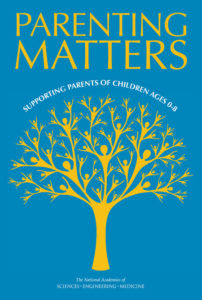 (2016) | Useful to Parent Centers in working with parents of young children, including ways Parent Centers can support interventions that help more parents learn about effective parenting practices.
(2016) | Useful to Parent Centers in working with parents of young children, including ways Parent Centers can support interventions that help more parents learn about effective parenting practices.
Parents are among the most important people in the lives of young children. While parents generally are filled with anticipation about their children’s unfolding personalities, many lack information and tools to support them in their parenting role and promote their children’s healthy development.
Parenting Matters: Supporting Parents of Children Ages 0-8 reviews research on parenting practices and identifies effective practices. The report also recommends ways agencies and others can support interventions that help more parents learn about effective parenting practices.
Read the report online or download it (400 pages) from the National Academies of Sciences, Engineering, and Medicine, at:
http://www.nap.edu/catalog/21868/parenting-matters-supporting-parents-of-children-ages-0-8
Read the Report in Brief (4 pages) or download the brief, at:
http://sites.nationalacademies.org/cs/groups/dbassesite/documents/webpage/dbasse_173455.pdf
Excerpt from the Report in Brief
(from page 1)
EFFECTIVE PARENTING PRACTICES
Research shows that parents who know more about child development are more likely to have quality interactions with their child and to act in ways that support their child’s healthy development. And parents with knowledge of specific evidence-based parenting practices are more likely to engage in those practices. Parenting practices that the committee found to be associated with positive child outcomes in areas of physical health and safety and many kinds of competence (emotional, behavioral, cognitive, and social) include:
- contingent responsiveness (“serve and return”)—adult behavior that occurs immediately in response to a child’s behavior and that is related to the child’s focus of attention, such as a parent smiling back at a child;
- showing warmth and sensitivity;
- routines and reduced household chaos;
- shared book reading and talking to children;
- practices that promote children’s health and safety—in particular, receipt of prenatal care, breastfeeding, vaccination, ensuring children’s adequate nutrition and physical activity, monitoring, and household/vehicle safety; and
- use of appropriate (less-harsh) discipline.

